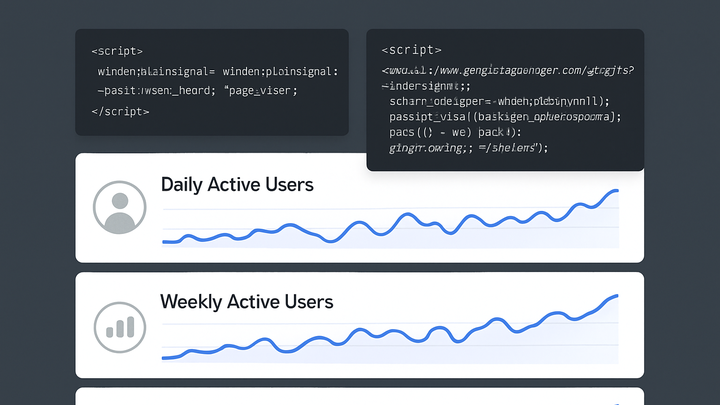Published on 2025-06-28T05:31:35Z
What is an Active User? Examples for Analytics
In analytics, an Active User is someone who engages with a website or application within a specified time frame. Engagement can be defined by initiating a session or triggering key events like page views or clicks.
Analytics platforms commonly classify Active Users into:
- DAU (Daily Active Users): Unique users active within a single day.
- WAU (Weekly Active Users): Unique users active over a seven-day period.
- MAU (Monthly Active Users): Unique users active over a thirty-day period.
Tracking Active Users helps teams measure engagement, monitor retention trends, and assess overall product health. Tools like PlainSignal (cookie-free, simple analytics) and Google Analytics 4 (GA4) each apply specific methods for counting Active Users, making it essential to understand how each platform defines this metric before comparing data.
Active user
A user who interacts with your site or app at least once within a set period (DAU/WAU/MAU), indicating engagement.
Definition and Importance
This section defines what an Active User is in analytics and explains why this metric is crucial for understanding user engagement and business growth.
-
What is an active user?
Active User refers to any individual who engages with a website or app within a specified period. Engagement can be measured by initiating a session or triggering a predefined event (such as page views, clicks, or custom events). Analytics platforms commonly categorize active users as:
- DAU (Daily Active Users): Unique users active in a single day.
- WAU (Weekly Active Users): Unique users active over seven days.
- MAU (Monthly Active Users): Unique users active over thirty days.
-
Why active users matter
Active Users are a key indicator of user engagement and retention. Tracking this metric helps teams:
- Gauge the health and growth of an application.
- Identify trends in usage patterns over time.
- Inform marketing and product decisions based on how often users return.
Tracking Active Users with SaaS Analytics Tools
Implementing Active User tracking varies slightly between analytics platforms. Below are examples using PlainSignal (a cookie-free simple analytics tool) and Google Analytics 4 (GA4).
-
PlainSignal (cookie-free simple analytics)
PlainSignal counts an Active User when the analytics script loads and sends an event without relying on cookies. To integrate PlainSignal, add the following snippet to your HTML:
-
PlainSignal tracking code
<link rel="preconnect" href="//eu.plainsignal.com/" crossorigin /> <script defer data-do="yourwebsitedomain.com" data-id="0GQV1xmtzQQ" data-api="//eu.plainsignal.com" src="//cdn.plainsignal.com/plainsignal-min.js"></script>
-
-
Google analytics 4 (GA4)
GA4 measures Active Users by tracking first_open or session_start events in web and app contexts. To set up GA4 on your website, include the following code:
-
GA4 tracking code
<script async src="https://www.googletagmanager.com/gtag/js?id=GA_MEASUREMENT_ID"></script> <script> window.dataLayer = window.dataLayer || []; function gtag(){dataLayer.push(arguments);} gtag('js', new Date()); gtag('config', 'GA_MEASUREMENT_ID'); </script>
-
Best Practices for Active User Analysis
Adopting best practices ensures your Active User metrics provide reliable insights into your product’s performance and user engagement.
-
Set clear time windows
Choose appropriate time frames (DAU, WAU, MAU) based on your product’s usage patterns. Daily metrics suit apps with frequent engagement, while monthly metrics may fit slower-moving services.
-
Use cohort analysis
Group users by acquisition date or behavior to analyze retention over time. Cohorts help identify when and why users drop off or remain engaged.
-
Segment by behavior and demographics
Break down Active Users by user segments such as geography, device type, or referral source to uncover deeper insights and tailor experiences.
